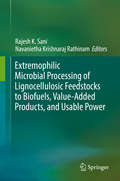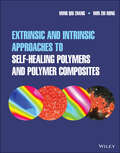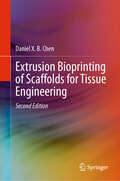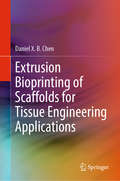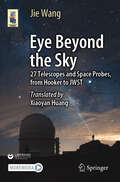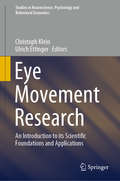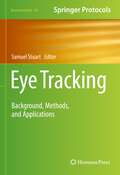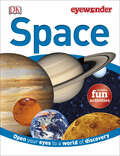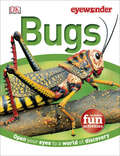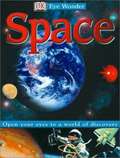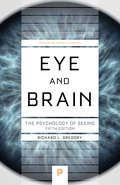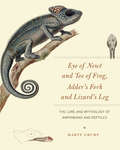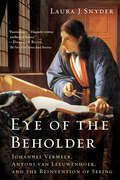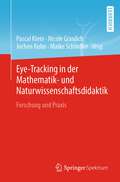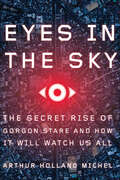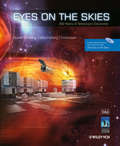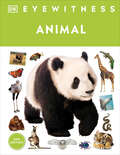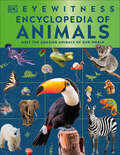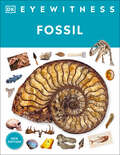- Table View
- List View
Extremophilic Microbial Processing of Lignocellulosic Feedstocks to Biofuels, Value-Added Products, and Usable Power
by Rajesh K. Sani Navanietha Krishnaraj RathinamThis book presents a review and in-depth analyses of improved biotechnological processes emphasizing critical aspects and challenges of lignocellulosic biomass conversion into biofuels and value-added products especially using extremophiles and recombinant microorganisms. The book specifically comprises extremophilic production of liquid and gaseous biofuels (bioethanol, biobutanol, biodiesel, biohydrogen, and biogas) as well as value added products (e.g. single cell protein, hydrocarbons, lipids, exopolysaccharides, and polyhydroxyalkanoates). The book also provides the knowledge on how to develop safe, more efficient, sustainable, and economical integrated processes for enhanced conversion of lignocellulosic feedstocks to liquid and gaseous biofuels. Finally the book describes how to perform the techno-economical and life-cycle assessments of new integrated processes involving extremophiles. These modeling exercises are critical in addressing any deficiencies associated with the demonstration of an integrated biofuels and value-added products production process at pilot scale as well as demonstration on the commercialization scale.
Extrinsic and Intrinsic Approaches to Self-Healing Polymers and Polymer Composites
by Ming Qiu Zhang Min Zhi RongExplore the cutting-edge in self-healing polymers and composites In Extrinsic and Intrinsic Approaches to Self-Healing Polymers and Polymer Composites, a pair of distinguished materials scientists delivers an insightful and up-to-date exploration of the fundamentals, theory, design, fabrication, characterization, and application of self-healing polymers and polymer composites. The book discusses how to prepare self-healing polymeric materials, how to increase the speed of crack repair, high temperature applications, and how to broaden the spectrum of healing agent species. The authors emphasize the integration of existing techniques with novel synthetic approaches for target-oriented materials design and fabrication. They provide a comprehensive view of this emerging field, allowing new researchers to gather a firm understanding of the framework for creating new materials or applications. Additionally, the book includes: A thorough introduction to the field of self-healing polymers and polymer composites, including the advances made by various laboratories and the challenges, trends, and future directions that characterize modern research in the area Comprehensive explorations of the self-healing strategies proposed by the authors, including addition polymerization, systems-based microcapsules and plastic tubes, and more Practical discussions of the application of reversible S-S bonds in self-healing polymers In-depth examinations of intrinsic self-healing via reversible C-ON bonds Perfect for polymer and materials scientists, chemists, and engineers, Extrinsic and Intrinsic Approaches to Self-Healing Polymers and Polymer Composites will also earn a place in the libraries of professionals working in the polymer, coatings, paints, medical, defense, and pharmaceutical industries.
Extrusion Bioprinting of Scaffolds for Tissue Engineering
by Daniel X. ChenThis book introduces readers to the theory and practice of extrusion bioprinting of scaffolds for tissue engineering and modeling. The text emphasizes the fundamentals and practical applications of extrusion bioprinting for scaffold fabrication, in a manner particularly suitable for those (including both undergraduate and graduate students) who wish to master the subject matter and apply it to real tissue engineering. Readers will learn how to design, fabricate, and characterize tissue scaffolds to be created by extrusion bioprinting technologies. This book: Covers tissue engineering and various scaffold fabrication techniques Presents the general requirements imposed on scaffolds and the scaffold design process Discusses the preparation and characterization of biomaterials and bioink for extrusion bioprinting Educates readers regarding how to bioprint and characterize scaffolds with living cells for tissue engineering and modeling Introduces the common methods/ techniques used to measure and characterize the mechanical properties of native tissues and scaffolds Discusses various approaches to create vascular networks within tissue scaffolds to facilitate their functions Introduces the concept of controlled release and the common strategies for regulating biomolecules in tissue engineering and printed scaffolds Includes many case studies of bioprinting and characterizing scaffolds for tissue engineering and modeling, to reflect the recent advances in the field of bioprinting
Extrusion Bioprinting of Scaffolds for Tissue Engineering Applications
by Daniel X. ChenThis book introduces readers to the theory and practice of extrusion bio-printing of scaffolds for tissue engineering applications. The author emphasizes the fundamentals and practical applications of extrusion bio-printing to scaffold fabrication, in a manner particularly suitable for those who wish to master the subject matter and apply it to real tissue engineering applications. Readers will learn to design, fabricate, and characterize tissue scaffolds to be created by means of extrusion bio-printing technology.
Eye Beyond the Sky: 27 Telescopes and Space Probes, from Hooker to JWST (Astronomers' Universe)
by Jie WangThis book highlights stories of the most important 13 ground-based observatories and 14 space probes in human history, leading readers through each significant step of human’s astronomical observation journey. From the earliest Hooker Telescope and the Mount Wilson Observatory, to the latest FAST, JWST and DAMPE, the targets of observation range from large systems such as the solar system, the milky way, and the universe, to individual planets such as Jupiter, Saturn, Mars, and the remote stars, and to the matters that reveal the origin of the universe, such as dark matter and cosmic background radiation. The book presents the mysteries of the sky in an easily readable manner suitable for audiences of all ages who are curious about the universe and thirsty to know all the important discoveries in the past century, especially the last decade. With carefully-selected contents, the book weaves together a series of tales to make the convoluted history of astronomical observation full offun and excitement, ensuring that readers never lose interest during reading.
Eye Movement Research: An Introduction to its Scientific Foundations and Applications (Studies in Neuroscience, Psychology and Behavioral Economics)
by Christoph Klein Ulrich EttingerThis edited volume presents fundamentals as well as applications of oculomotor methods in industrial and clinical settings. The topical spectrum covers 1.) basics and background material, 2.) methods such as recording techniques, markov models, Lévy flights, pupillometry and many more, as well as 3.) a broad range of applications in clinical and industrial settings. The target audience primarily comprises research experts and practitioners, but the book may also be beneficial for graduate students.
Eye Tracking: Background, Methods, and Applications (Neuromethods #183)
by Samuel StuartThis volume explores the latest eye-tracking methodologies that help researchers understand the background, methods, and applications involved in these studies. The chapters in this book cover topics such as methods and models of eye-tracking in natural environments; natural gaze informatics (i.e., assisted wheelchair mobility); eye-tracking application to understand the visual control of locomotion; eye movement in neurological disorders; and eye movements in sports research and practice. In the Neuromethods series style, chapters include the kind of detail and key advice from the specialists needed to get successful results in your laboratory. Cutting-edge and practical, Eye Tracking: Background, Methods, and Applications is a valuable resource for experienced and novice researchers interested in learning more about this field and its future developments.
Eye Wonder: Open Your Eyes to a World of Discovery (Eye Wonder)
by Carole StottOpen your eyes to a world of discovery. Travel from Earth to the ends of the known universe. Space is a colorful first guide to astronomy packed with facts about space exploration, the solar system, planets, stars, galaxies, and much more. Dramatic, atmospheric photography provides a wealth of visual information. Packed with facts and written in an accessible style, Eye Wonders are the perfect educational start for young children. A groundbreaking reference series specially developed for younger children aged five plus. In a stunning style departure for DK, wonderful photography shows subjects within their natural setting, offering a whole new level of information through powerful images. Vocabulary is accessible to children aged five plus, with the meanings of new, subject-related words clearly explained. The series provides an excellent knowledge base on the natural world for children starting to learn. The combination of breathtaking visuals and informative, accurate text will hook even those children who usually avoid books.
Eye Wonder: Open Your Eyes to a World of Discovery (Eye Wonder)
by DKOpen your eyes to a world of discovery. Enter the extraordinary empire of the creepy-crawly. From dung beetles to dragonflies, meet the neighbors you rarely see -- but are essential to your life. A wealth of facts, combined with dramatic photography, ensures that Eye Wonders are the perfect educational start for young children. Eye Wonders is a groundbreaking reference series specially developed for younger children aged five plus. In a stunning style departure for DK, wonderful photography shows subjects within their natural setting, offering a whole new level of information through powerful images. Vocabulary is accessible to children aged five plus, with the meanings of new, subject-related words clearly explained. The series provides an excellent knowledge base on the natural world for children starting to learn. The combination of breathtaking visuals and informative, accurate text will hook even those children who usually avoid books.
Eye Wonder: Space
by Mary Ling Simon Holland Carole StottOpen your eyes to a world of discovery. Travel from Earth to the ends of the known universe. Space is a colorful first guide to astronomy packed with facts about space exploration, the solar system, planets, stars, galaxies, and much more. Dramatic, atmospheric photography provides a wealth of visual information. Packed with facts and written in an accessible style, Eye Wonders are the perfect educational start for young children. A groundbreaking reference series specially developed for younger children aged five plus. In a stunning style departure for DK, wonderful photography shows subjects within their natural setting, offering a whole new level of information through powerful images. Vocabulary is accessible to children aged five plus, with the meanings of new, subject-related words clearly explained. The series provides an excellent knowledge base on the natural world for children starting to learn. The combination of breathtaking visuals and informative, accurate text will hook even those children who usually avoid books.
Eye and Brain: The Psychology of Seeing
by R. L. GregoryWe are so familiar with seeing, that it takes a leap of imagination to realise that there are problems to be solved. But consider it. We are given tiny distorted upside-down images in the eyes, and we see separate solid objects in surrounding space. From the patterns of stimulation on the retinas we perceive the world of objects, and this is nothing short of a miracle.
Eye and Brain: The Psychology of Seeing
by Richard L. GregorySince the publication of the first edition in 1966, Eye and Brain has established itself worldwide as an essential introduction to the basic phenomena of visual perception. Richard Gregory offers clear explanations of how we see brightness, movement, color, and objects, and he explores the phenomena of visual illusions to establish principles about how perception normally works and why it sometimes fails. Illusion continues to be a major theme in the book, which provides a comprehensive classification system. There are also sections on what babies see and how they learn to see, on motion perception, the relationship between vision and consciousness, and on the impact of new brain imaging techniques. sentation of the text and illustrations has been improved by the larger format and new page design. The thousands of readers of the previous editions of Eye and Brain will find this new revised edition even more attractive and enthralling.
Eye and Brain: The Psychology of Seeing (Fifth edition)
by Richard L. GregorySince the publication of the first edition in 1966, Eye and Brain has established itself worldwide as an essential introduction to the basic phenomena of visual perception. In this book, Gregory offers clear explanations of how we see brightness, movement, color, and objects, and he explores the phenomena of visual illusions to establish principles about how perception normally works and why it sometimes fails. Although successive editions have incorporated new discoveries and ideas, this is the first time that Richard Gregory has completely revised and updated the text, adding more than thirty new illustrations. The phenomena of illusion continue to be a major theme in the book, in which the author makes a new attempt to provide a comprehensive classification system. There are also new sections on what babies see and how they learn to see, on motion perception, and tantalizing glimpses of the relationship between vision and consciousness and of the impact of new brain imaging techniques. In addition, the presentation of the text and illustrations has been improved by the larger format and new page design. The thousands of readers of the previous editions of Eye and Brain will find this new revised edition even more attractive and enthralling.
Eye of Newt and Toe of Frog, Adder's Fork and Lizard's Leg: The Lore and Mythology of Amphibians and Reptiles
by Marty CrumpFrom celebrated herpetologist and science writer Marty Crump, a beautifully illustrated exploration of the interlinked stories of herp folklore, natural history, and conservation. Frogs are worshipped for bringing nourishing rains, but blamed for devastating floods. Turtles are admired for their wisdom and longevity, but ridiculed for their sluggish and cowardly behavior. Snakes are respected for their ability to heal and restore life, but despised as symbols of evil. Lizards are revered as beneficent guardian spirits, but feared as the Devil himself. In this ode to toads and snakes, newts and tuatara, crocodiles and tortoises, herpetologist and science writer Marty Crump explores folklore across the world and throughout time. From creation myths to trickster tales; from associations with fertility and rebirth to fire and rain; and from the use of herps in folk medicines and magic, as food, pets, and gods, to their roles in literature, visual art, music, and dance, Crump reveals both our love and hatred of amphibians and reptiles—and their perceived power. In a world where we keep home terrariums at the same time that we battle invasive cane toads, and where public attitudes often dictate that the cute and cuddly receive conservation priority over the slimy and venomous, she shows how our complex and conflicting perceptions threaten the conservation of these ecologically vital animals. Sumptuously illustrated, Eye of Newt and Toe of Frog, Adder’s Fork and Lizard’s Leg is a beautiful and enthralling brew of natural history and folklore, sobering science and humor, that leaves us with one irrefutable lesson: love herps. Warts, scales, and all.
Eye of the Beholder: Johannes Vermeer, Antoni van Leeuwenhoek, and the Reinvention of Seeing
by Laura J. SnyderThe remarkable story of how an artist and a scientist in seventeenth-century Holland transformed the way we see the world. On a summer day in 1674, in the small Dutch city of Delft, Antoni van Leeuwenhoek--a cloth salesman, local bureaucrat, and self-taught natural philosopher--gazed through a tiny lens set into a brass holder and discovered a never-before imagined world of microscopic life. At the same time, in a nearby attic, the painter Johannes Vermeer was using another optical device, a camera obscura, to experiment with light and create the most luminous pictures ever beheld. "See for yourself!" was the clarion call of the 1600s. Scientists peered at nature through microscopes and telescopes, making the discoveries in astronomy, physics, chemistry, and anatomy that ignited the Scientific Revolution. Artists investigated nature with lenses, mirrors, and camera obscuras, creating extraordinarily detailed paintings of flowers and insects, and scenes filled with realistic effects of light, shadow, and color. By extending the reach of sight the new optical instruments prompted the realization that there is more than meets the eye. But they also raised questions about how we see and what it means to see. In answering these questions, scientists and artists in Delft changed how we perceive the world. In Eye of the Beholder, Laura J. Snyder transports us to the streets, inns, and guildhalls of seventeenth-century Holland, where artists and scientists gathered, and to their studios and laboratories, where they mixed paints and prepared canvases, ground and polished lenses, examined and dissected insects and other animals, and invented the modern notion of seeing. With charm and narrative flair Snyder brings Vermeer and Van Leeuwenhoek--and the men and women around them--vividly to life. The story of these two geniuses and the transformation they engendered shows us why we see the world--and our place within it--as we do today.
Eye of the Storm: NASA, Drones, and the Race to Crack the Hurricane Code
by Amy CherrixTen million Americans live in hurricane danger zones, but how do we know if or when to evacuate? We must predict both when a storm will strike and how strong it will be. A daring NASA earth science mission may have finally found a way to crack this hurricane code.Dr. Scott Braun is the principal investigator for the Hurricane and Severe Storm Sentinel mission (HS3), which flies repurposed military drone over hurricanes so that scientists can gather data. But the stakes are high and time is running out.In the first Scientists in the Field book entirely about weather, meet the NASA team on the cutting edge of meteorological field science.
Eye on the Universe
by Sean PriceNow in orbit 370 miles above Earth, the Hubble Space Telescope allows astronomers to see deeper into space and further back in time than ever before. Read about the challenges that scientists faced during Hubble's construction, and the five space walks, a record number, that astronauts made to correct a microscopic flaw in one of the telescope's mirrors.
Eye-Tracking in der Mathematik- und Naturwissenschaftsdidaktik: Forschung und Praxis
by Pascal Klein Jochen Kuhn Maike Schindler Nicole GraulichDieses Buch beschäftigt sich mit aktuellen Studien und Anwendungsmöglichkeiten von Eye-Tracking in der Mathematik- oder Naturwissenschaftsdidaktik: Was betrachten Lernende, wenn sie einen naturwissenschaftlichen Text lesen, mathematische Muster erkunden oder mit einem Diagramm arbeiten? Wie fokussieren und verteilen sie ihre Aufmerksamkeit beim Lösen mathematischer und naturwissenschaftlicher Aufgaben? Eye-Tracking liefert Antworten auf diese und weitere Fragen und kann somit dazu beitragen, Lernprozesse besser zu verstehen, Lernmaterialien und Lehrprozesse zu optimieren oder Unterschiede zwischen verschiedenen Expertisegruppen aufzudecken. Dieses Buch stellt aktuelle Studien aus der Mathematik- und Naturwissenschaftsdidaktik (Biologie, Chemie, Physik, Informatik) zusammen, die Eye-Tracking als zentrale Forschungsmethode zur Beantwortung von Fragestellungen entlang der Bildungskette (Primar- und Sekundarstufen sowie Universität) nutzen. Dabei wird deutlich, wie Eye-Tracking bereits etablierte Forschungsmethoden der empirisch forschenden Fachdidaktik, wie das Laute Denken, den Einsatz von Fragebögen oder Experteninterviews, ergänzt.Das Buch zeigt die vielfältigen Anwendungsmöglichkeiten von Eye-Tracking in der Mathematik- und Naturwissenschaftsdidaktik und enthält zahlreiche Best-Practice-Beispiele zum Design und zur Auswertung wissenschaftlicher Studien zum Thema. Das Buch richtet sich damit sowohl an Wissenschaftlerinnen und Wissenschaftler mit unterschiedlicher Erfahrung im Bereich Eye-Tracking als auch an (zukünftige) Lehrkräfte und Dozierende, da aus den empirischen Befunden Handlungsempfehlungen für den Unterricht bzw. die Lehre gegeben werden.
Eye-Tracking with Python and Pylink
by Zhiguo WangSeveral Python programming books feature tools designed for experimental psychologists. What sets this book apart is its focus on eye-tracking.Eye-tracking is a widely used research technique in psychology and neuroscience labs. Research grade eye-trackers are typically faster, more accurate, and of course, more expensive than the ones seen in consumer goods or usability labs. Not surprisingly, a successful eye-tracking study usually requires sophisticated computer programming. Easy syntax and flexibility make Python a perfect choice for this task, especially for psychology researchers with little or no computer programming experience.This book offers detailed coverage of the Pylink library, a Python interface for the gold standard EyeLink ® eye-trackers, with many step-by-step example scripts. This book is a useful reference for eye-tracking researchers, but you can also use it as a textbook for graduate-level programming courses.
Eyes In The Sky: The Secret Rise of Gorgon Stare and How It Will Watch Us All
by Arthur Holland MichelThe fascinating history and unnerving future of high-tech aerial surveillance, from its secret military origins to its growing use on American citizensEyes in the Sky is the authoritative account of how the Pentagon secretly developed a godlike surveillance system for monitoring America's enemies overseas, and how it is now being used to watch us in our own backyards. Whereas a regular aerial camera can only capture a small patch of ground at any given time, this system—and its most powerful iteration, Gorgon Stare—allow operators to track thousands of moving targets at once, both forwards and backwards in time, across whole city-sized areas. When fused with big-data analysis techniques, this network can be used to watch everything simultaneously, and perhaps even predict attacks before they happen. In battle, Gorgon Stare and other systems like it have saved countless lives, but when this technology is deployed over American cities—as it already has been, extensively and largely in secret—it has the potential to become the most nightmarishly powerful visual surveillance system ever built. While it may well solve serious crimes and even help ease the traffic along your morning commute, it could also enable far more sinister and dangerous intrusions into our lives. This is closed-circuit television on steroids. Facebook in the heavens. Drawing on extensive access within the Pentagon and in the companies and government labs that developed these devices, Eyes in the Sky reveals how a top-secret team of mad scientists brought Gorgon Stare into existence, how it has come to pose an unprecedented threat to our privacy and freedom, and how we might still capitalize on its great promise while avoiding its many perils.
Eyes on the Skies: 400 Years of Telescopic Discovery
by Govert Schilling Lars Lindberg ChristensenAdopted as the official book of the International Year of Astronomy (IYA) 2009, this stunningly illustrated history of telescopic discovery spans the range from the first telescopes via the Hubble Space Telescope to next generation platforms, and how they have changed and continue to change our view of the universe, our place in it and where it all came from. EYES ON THE SKIES features numerous full-page photographs and is printed in high-quality color throughout. Also includes the official IYA DVD with 59 minutes of narrated text, expert comments and interviews, animations, computer simulations, science results, plus footage from observatories.
Eyes, Nose, Belly, Toes: My First Human Body Book
by Krupa Bhojani Playforth MDAll about the human body for kids 1 to 3!"All kids will see themselves in this beautiful book, intentionally designed to help toddlers learn about the amazing things their bodies can do." — Emily Oster, CEO of ParentData and bestselling author of Expecting Better, Cribsheet, and The Family Firm.Learning how the human body works is an important skill for toddlers. This adorable kids anatomy book walks them through every major body part, with simple language and vibrant artwork that keep them engaged as they explore how they use their eyes to see, their nose to smell, their legs to move, and their arms to wave hello!Colorful illustrations—Read along with your child and explore exciting pictures that show kids the body parts they use at playtime, bathtime, snacktime, and more.Which body part is that?—Help your child learn to point out their belly button, count their fingers and touch their elbows!Learning and growing—Make it fun for kids to learn body vocabulary and start to discover all the amazing things their bodies can do.Get this book today and enjoy educational quality time with your child.
Eyewitness Animal (DK Eyewitness)
by DKDelve into the enchanting world of animals with this book filled with breathtaking images and incredible facts.Which animal is the tallest? What's the difference between frogs and toads? Find out in Eyewitness Animal and become an animal expert. From creepy crawlies and bugs to the blue whale, discover all about animal behavior and evolution. Study the body systems and senses of various animal groups, and explore their varied habitats and diets. There is so much to discover in this comprehensive book. Read about what it is like to be a wildlife expert and see how they study animals in their natural habitat. Learn about animals that have been extinct for millions of years and find out what can be done to conserve those on the verge of extinction. Find out what animals are part of different myths and legends across cultures and why. Eyewitness reference books are now more interactive and colorful, with new infographics, statistics, facts, and timelines. Great for projects or just for fun, learn everything you need to know about animals in this fact-filled book for kids.
Eyewitness Encyclopedia of Animals (DK Eyewitness)
by DKExperience the world's most incredible animals in one amazing book.Become an eyewitness to the world’s most amazing animals in this picture-led encyclopedia which will take children aged 9+ on a tour of the marvellous animal kingdom. Like the hugely successful Eyewitness series itself, Eyewitness Encyclopedia of Animals includes every animal topic children want to read about. The world's most amazing animals are here, from tiny ants to the mighty blue whale and soaring eagles to relaxed sloths. Each page is illustrated with jaw-dropping photography and filled with facts and images that are ideal for children aged 9+. This fact-packed animal encyclopedia for children offers: The next book in the new Eyewitness Encyclopedia series, following the epic Eyewitness Encyclopedia of Everything that’s sold over 100,000 copies.Exciting photography, more than 1,500 images, and a clear design, familiar from the rebooted Eyewitness series.Features that are full of facts and stats, quizzes, and interviews with experts, including deep sea explorers and veterinary surgeons, who answer kids' questions about what they do and why they love it.Eyewitness Encyclopedia of Animals introduces the ultimate guide to the wonders of wildlife, from deadly predators to beautiful butterflies, all as you've never seen them before. And meet the experts who study them, from entomologists to zoologists, in absorbing Q&As that explain what they do. With its mix of nerdy knowledge, fun facts, and incredible images, this extraordinary book will keep kids engaged for hours.
Eyewitness Fossil (DK Eyewitness)
by DKA visual and informative guide to fossils, now revised and updated in the relaunched DK Eyewitness Books format.Get up close and personal and be an eyewitness to our prehistoric world through fossilized shells, skulls, teeth, plants, and, of course, skeletons with DK Eyewitness Books: Fossil. Discover the most precious fossils in the world; see how fossils form; find out how early historians and scientists used fossils; and learn how you can become a paleontologist with the included fossil guide.DK Eyewitness Books: Fossil unlocks our prehistoric world.Series Overview: Each revised Eyewitness book retains the stunning artwork and photography from the groundbreaking original series, but the text has been reduced and reworked to speak more clearly to younger readers. Still on every colorful page: vibrant annotated photographs and the integrated text-and-pictures approach that makes Eyewitness a perennial favorite of parents, teachers, and school-age kids.
